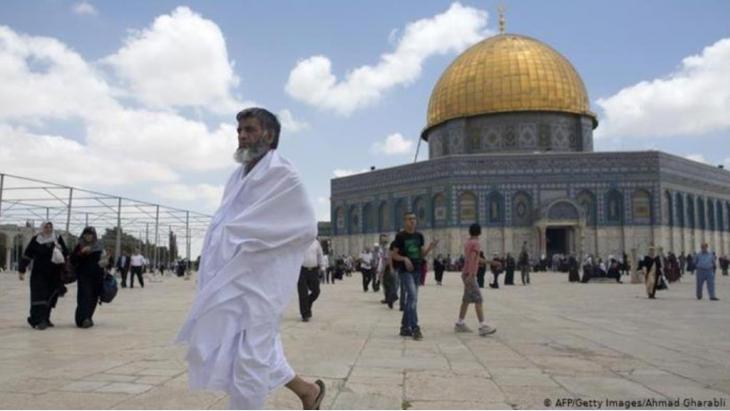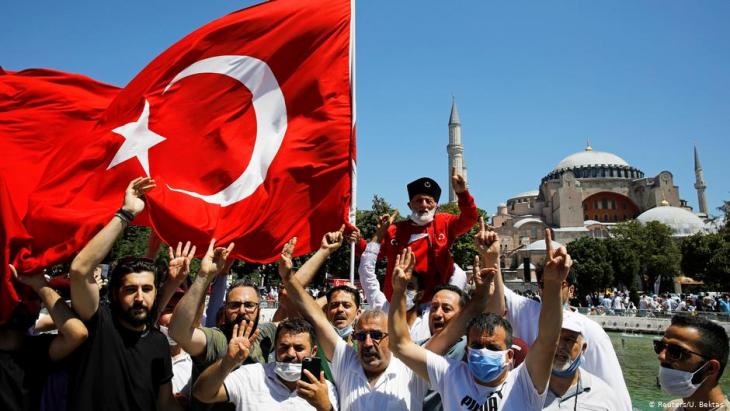The new Saladin

The conversion of Hagia Sophia back into a mosque was a spectacular move. Some saw this change in the status of this publicly accessible site with its magnificent art, frescoes and architecture as sacrilege, but for Turkish President Recep Tayyip Erdoğan, it constituted a "resurrection", indeed, a "harbinger" for the liberation of the next holy site, the Al-Aqsa Mosque in Jerusalem.
When proclaiming this mission, Erdoğan used the Turkish term "Mescid-i Aksa", which, similar to the Arabic term "Al-Masjid Al-Aqsa", has long meant not only the mosque but the entire Temple Mount. Another reason why the term is preferred to "Al-Haram Al-Sharif" (venerable sanctuary), which was once in common use, is because it is mentioned in the Koran in connection with Muhammad's Night Journey from Mecca to Jerusalem.
This rhetoric is intended not only to make Muslims more aware that the Temple Mount in Jerusalem is the third holiest place in Islam; its consistent use is in fact part of a global Muslim campaign to guard the site against Israeli control.
Campaign to "liberate Al-Aqsa"
Turkish Islamists joined the campaign years ago and can be assured the support of the Turkish state and foundations close to it. The fact that the call to "liberate Al-Aqsa" – which was long heard in such circles – is also being voiced by the Turkish head of state himself, has elevated the mission to official Turkish state ideology.
Erdoğan’s rallying cry regarding Al-Aqsa is being spread via all possible channels. On the day of the re-consecration of Hagia Sophia, the words were already emblazoned on posters put up in various cities by the "Turkish Youth Foundation", which has close links to the state. Activists from the foundation, on whose board of directors Erdoğan's son Bilal sits, distributed sweets to mosque visitors and passers-by, who congratulated them on the "resurrection" of Hagia Sophia – and the imminent "liberation of Al-Aqsa".
This slogan is now also being propagated by Ali Erbaş, who has been president of the Turkish religious authority Diyanet since September 2017. Immediately after taking office, Erbaş ostentatiously posted on his Twitter and Facebook pages a photo of the Temple Mount – taken from the east, the occupied part of the city. He thus avoided including the Wailing Wall, frequented by Jews, in his picture. This perspective is consistent with the Islamist denial of the Jewish claim to the Temple Mount.
Erbaş's predecessor Mehmet Görmez is likewise agitating for Al-Aqsa and put in a spectacular appearance in Jerusalem to pronounce this claim. In May 2015, Görmez delivered an incendiary sermon in Arabic at the Al-Aqsa Mosque, which was broadcast by the Turkish state-run television station Diyanet-TV and celebrated as "historic". He praised his Palestinian hosts for their "holy war in defence of the blessed Al-Aqsa Mosque" and appealed to Muslims around the world to support the Palestinians.
Turkish flags outside the Dome of the Rock
The Turkish Al-Aqsa campaign gained considerable traction when, following the Trump administration's official recognition of Jerusalem as the capital of Israel in December 2017, Erdoğan called on all Muslims to convene on the Temple Mount. Since then, more and more groups of Turkish pilgrims have travelled there, demonstratively holding up Turkish flags and posters with Erdoğan's portrait outside the Dome of the Rock. Turks from Germany also joined in.The Israeli police reacted promptly by prohibiting Turkish tourists from displaying political symbols on the plateau or wearing the red fez, the traditional Ottoman headwear. When Belgian-Turkish visitors resisted the ban, they were arrested and expelled from the country. In the summer of 2018, the case of a group of 80 Muslim pilgrims from Turkey who were refused entry into Israel at Ben Gurion Airport caused a stir.

But even such measures apparently cannot prevent the network of relations between Turks and Palestinians from becoming ever denser, especially in East Jerusalem. This closing of ranks is being watched with suspicion in Israel, especially by right-wing media, which recently sounded the alarm, warning of a "Turkish Islamic centre" near the Temple Mount, describing it as the "base of revolutionary Islam in the heart of Jerusalem".
The reality is, however, far less dramatic. The "base" is actually a shop in the Muslim quarter not far from the Wailing Wall whose Palestinian owner, Emad Abu Khadija, accidentally came across vaults from the Ayyubid period (1171 to 1252) during construction work a few years ago. Their restoration was then funded by the powerful state-run "Turkish Cooperation and Coordination Agency" (TIKA), which supports numerous aid projects in the Palestinian territories. Today, the premises house a souvenir shop and a restaurant that is popular with Turkish tourists.
Local Palestinian-Islamic patriotism
Government-affiliated media in Turkey quickly picked up the story and reported that Abu Khadija's "archaeological" discovery had brought him into conflict with the Israeli authorities, whose claims of ownership he was, however, able to fend off. Abu Khadija likes to talk about this triumph and about his refusal of allegedly million-dollar offers to buy his restaurant. He knows just how to combine business with local Palestinian-Islamic patriotism. He thus now calls his shop "Khan Abu Khadija" in reference to the Arabic term for caravanserai (Chan) and has adorned its sign with a silhouette of the Dome of the Rock.
Pious Turkish travellers evidently feel at home here because the "Khan", which they consider to be an Ottoman building, offers them a familiar ambience with fitting Neo-Ottoman décor: portraits of Sultan Abdul Hamid II and Erdoğan, red fezzes and Turkish flags. For a time, a TIKA agency flag was also part of this backdrop. Then it was discovered by the Israelis and presented as the ultimate proof of Ankara's interference. This is one of the reasons why Abu Khadija has now covered a marble plaque in the wall on which TIKA expresses its support for the Palestinian people with a cloth showing verses from the Koran.
Saladin analogy is widespread among AKP supporters
The Turkish Al-Aqsa campaign serves in part to spread state-prescribed Neo-Ottomanism. The Istanbul-based association "Mirasimiz" (Our Heritage) strives to "protect and preserve the Ottoman heritage in and around Jerusalem". Mirasimiz sees the restoration of sacred buildings dating from the Ottoman era, which the association supports financially and logistically in cooperation with the Turkish Agency for Cooperation and Coordination, as cultural resistance to the Israeli occupation and the progressive "Judaisation" of East Jerusalem.

The association's journal, Minber-i Aksa (Al-Aqsa Pulpit), repeatedly draws attention to the Ottoman heritage in Palestine, and in the case of the Temple Mount, it goes overboard in glorifying the achievements of Ottoman rulers there as builders and guardians of the sanctuaries. The small buildings left by the Ottomans there are often featured in the journal.
No mention is made, however, of the way that the Al-Aqsa Mosque and the Dome of the Rock were severely neglected in the late Ottoman period. Instead, an article in the latest issue of Minber-i Aksa reports in detail on the restoration work carried out on the Al-Aqsa Mosque, focusing in particular on the efforts undertaken from 1922 to 1925 by Mimar Kemaleddin, a Turkish architect who was trained in Berlin. The account fails to mention the Egyptian and British experts who were also deeply involved in the project, emphasising instead how Kemaleddin was honoured by the British for his work.
The "Minber-i Aqsa" association, likewise based in Istanbul, has also played a prominent role in the Turkish Al-Aqsa campaign – just one of a growing number of government-affiliated organisations and media initiatives in Turkey committed to an Islamic Jerusalem. For the last three years or so, "Minber-i Aqsa" has been trying to recruit legal scholars from as many Islamic countries as possible for the Turkish campaign. At an international conference on the subject in Istanbul in the summer of 2018, which attracted 400 participants, the city's Mufti, Hasan Kamil Yilmaz, conjured the vision of a new Saladin who would soon set out to liberate the "usurped" city of Jerusalem.
The Istanbul mufti may well have had Erdoğan in mind here, but so far, state officials and AKP functionaries have refrained from comparing Erdoğan to Saladin. When the AKP politician and director of the district administration of Iznik (Bursa province) Halil Ibrahim Gökbulut quoted Erdoğan's Al-Aqsa slogan while speaking to the faithful before the reopening of Hagia Sophia as a mosque, he referred to the Turkish President as "Saladin of the Umma" (Saladin of the community of Muslims), the opposition Kemalist newspaper Sözcü deemed it sensational.
On Turkish social media, however, the Saladin analogy is already widespread among AKP supporters – as is the dismay this vision generates among their opponents.
Joseph Croitoru
© Qantara.de 2020
Translated from the German by Jennifer Taylor